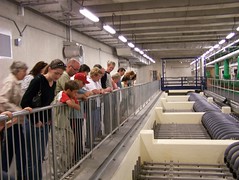The Water System of St. John’s developed in two parts, and was not an outstanding success from the outset. Indeed, the challenges of supplying water to St. John’s took the best part of a century to resolve. Originally designed by British engineers, the system was plagued with problems that the engineering know-how and technology of the time seemed ill-equipped to deal with.
The original Water System of St. John’s consists of George’s Pond on Signal Hill (1846) and Windsor Lake, north of the city (1860), together with transmission mains and distribution networks throughout the older parts of St. John’s, along with historic screen houses and chlorination plants. It is the second oldest water system in Atlantic Canada, and only three water systems are known to exist in British North America before 1850.
The Water System allowed for the development of the city through security of supply of good, usable water, helped ensure the health and well-being of the citizens of St. John’s through the avoidance of water-borne disease following the cholera epidemic of 1854. It also helped spur the development of a workable, planned and efficient sewer system. Although initially built to prevent catastrophic fire and loss of property, the failure of the water system in July, 1892 resulted in the almost total destruction of the city in The Great Fire.
The Water System spurred local industrial development, including the casting of cast iron water pipe in the city (1860), and the making of locally fired clay brick for roofing over sewers and trenches, both previously imported from foreign sources. It also had unexpected impacts well beyond the reach of a water main. It helped break the stranglehold of absent and foreign landlordism that hampered local ownership of property, it created a mechanism which established civic numbering of property in the city, and it paved the way for the creation of municipal government in Newfoundland.
The original Windsor Lake supply continues to supply the City of St. John’s with excellent quality water in quantity, some 148 years later.
